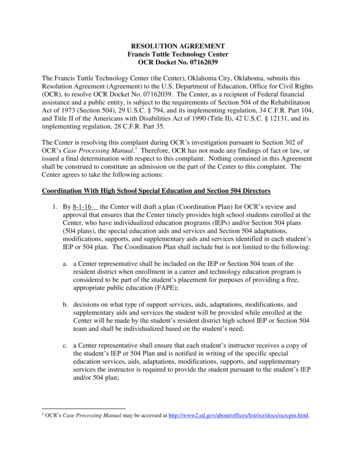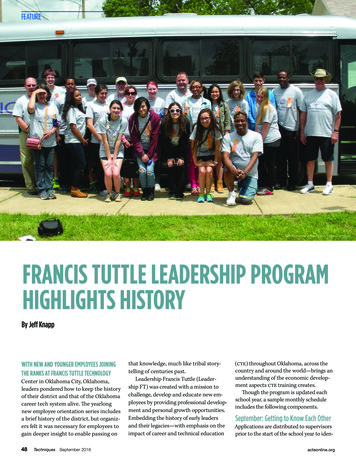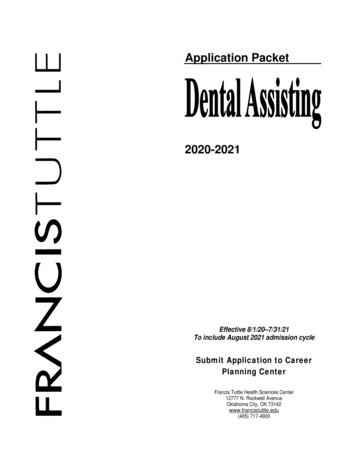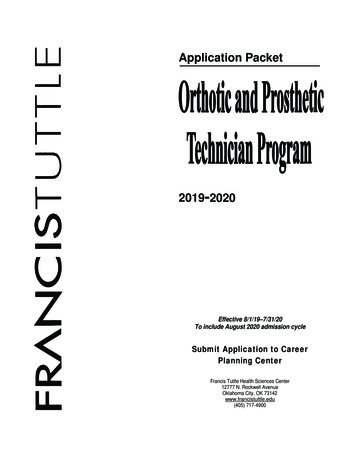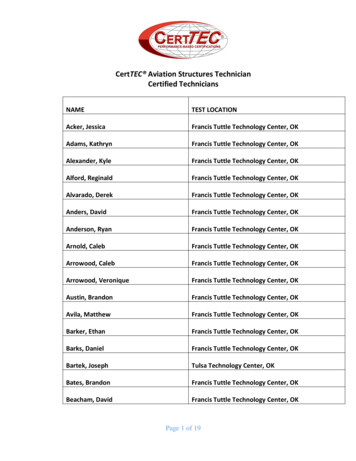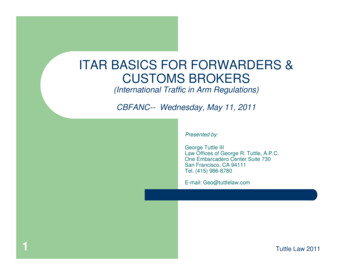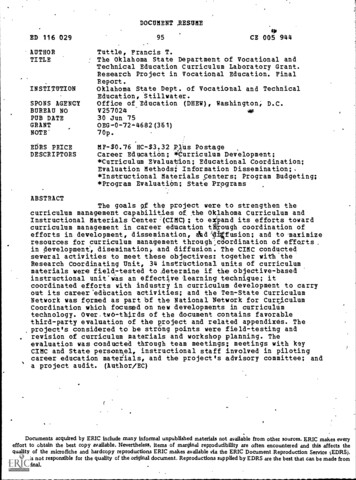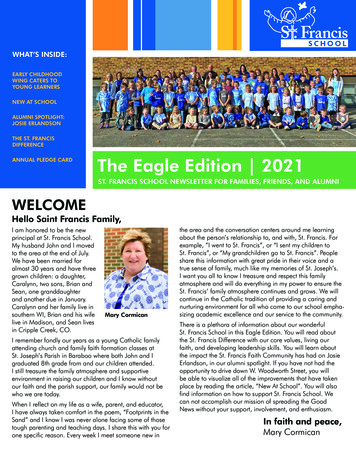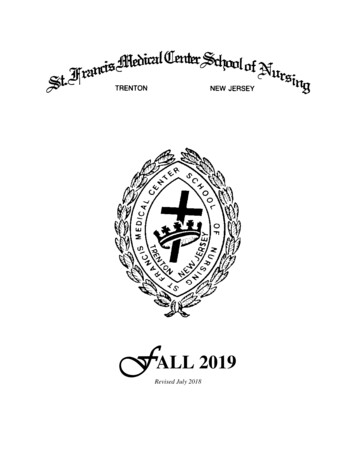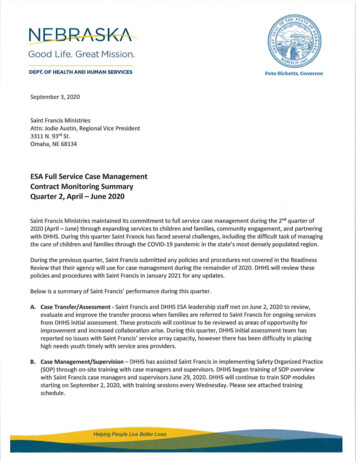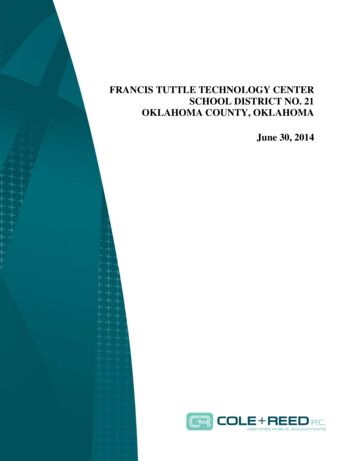
Transcription
FRANCIS TUTTLE TECHNOLOGY CENTERSCHOOL DISTRICT NO. 21OKLAHOMA COUNTY, OKLAHOMAJune 30, 2014
FRANCIS TUTTLE TECHNOLOGY CENTERSCHOOL DISTRICT NO.21OKLAHOMA COUNTYJune 30, 2014SCHOOL DISTRICT OFFICIALSFINANCIAL SECTIONINDEPENDENT AUDITORS’ REPORT . 1MANAGEMENT’S DISCUSSION AND ANALYSIS . 4BASIC FINANCIAL STATEMENTSStatement of Net Position . 17Statement of Activities . 18Balance Sheet-Governmental Funds . 19Reconciliation of the Governmental Funds Balance Sheet to the Statement of Net Position . 20Statement of Revenues, Expenditures, andChanges in Fund Balances-Governmental Funds . 21Reconciliation of the Statement of Revenues, Expenditures, andChanges in Fund Balances of Governmental Funds to the Statement of Activities . 22Statement of Net Position-Proprietary Fund . 23Statement of Revenues, Expenses, andChanges in Net Position-Proprietary Fund . 24Statement of Cash Flows-Proprietary Fund . 25Statement of Fiduciary Assets and Liabilities – Agency Fund . 26Notes to the Financial Statements . 27REQUIRED SUPPLEMENTARY INFORMATIONBudgetary Comparison Schedule - General Fund. 55Budgetary Comparison Schedule - Building Fund . 56OTHER SUPPLEMENTARY INFORMATIONStatement of Changes in Assets and Liabilities – Agency Fund . 57
REPORTS REQUIRED BY GOVERNMENT AUDITING STANDARDSAND OMB CIRCULAR A-133Independent Auditors’ Report on Internal Control Over FinancialReporting and on Compliance and Other Matters Based on an Audit ofFinancial Statements Performed in Accordance With Government Auditing Standards . 58Independent Auditors’ Report on Compliance for Each Major FederalProgram; Report on Internal Control over Compliance; and Report onSchedule of Expenditures of Federal Awards Required by OMB Circular A-133. 60Schedule of Expenditures of Federal Awards . 63Schedule of Findings and Questioned Costs . 64Summary Schedule of Prior Audit Findings . 66OTHER INFORMATIONSchedule of Accountants’ Professional Liability Insurance Affidavit . 67
SCHOOL DISTRICT OFFICIALS
FRANCIS TUTTLE TECHNOLOGY CENTERSCHOOL DISTRICT NO. 21, OKLAHOMA COUNTYSCHOOL DISTRICT OFFICIALSJUNE 30, 2014BOARD OF EDUCATIONPresidentSuzette Northcutt RhodesVice-PresidentDavid GilloglyClerkPaul “Buddy” SanfordMemberBob TurnerMemberKurt LoeffelholzMINUTES CLERKJudie HarrisSUPERINTENDENT OF SCHOOLSDr. Tom FriedemannSCHOOL DISTRICT TREASURERJ. Bruce Campbell
FINANCIAL SECTION
INDEPENDENT AUDITORS’ REPORT
Independent Auditors’ ReportTo the Board of EducationFrancis Tuttle Technology Center School District No. 21Oklahoma City, OklahomaReport on the Financial StatementsWe have audited the accompanying financial statements of the governmental activities, each major fund,and the aggregate remaining fund information of Francis Tuttle Technology Center School District No. 21(the “District”), Oklahoma County, Oklahoma, as of and for the year ended June 30, 2014, and the relatednotes to the financial statements, which collectively comprise the District’s basic financial statements aslisted in the table of contents.Management’s Responsibility for the Financial StatementsManagement is responsible for the preparation and fair presentation of these financial statements inaccordance with accounting principles generally accepted in the United States of America; this includesthe design, implementation, and maintenance of internal control relevant to the preparation and fairpresentation of financial statements that are free from material misstatement, whether due to fraud orerror.Auditors’ ResponsibilityOur responsibility is to express opinions on these financial statements based on our audit. We conductedour audit in accordance with auditing standards generally accepted in the United States of America andthe standards applicable to financial audits contained in Government Auditing Standards, issued by theComptroller General of the United States. Those standards require that we plan and perform the audit toobtain reasonable assurance about whether the financial statements are free of material misstatement.An audit involves performing procedures to obtain audit evidence about the amounts and disclosures inthe financial statements. The procedures selected depend on the auditor’s judgment, including theassessment of the risks of material misstatement of the financial statements, whether due to fraud orerror. In making those risk assessments, the auditor considers internal control relevant to the entity’spreparation and fair presentation of the financial statements in order to design audit procedures that areappropriate in the circumstances, but not for the purpose of expressing an opinion on the effectiveness ofthe entity’s internal control. Accordingly, we express no such opinion. An audit also includes evaluatingthe appropriateness of accounting policies used and the reasonableness of significant accountingestimates made by management, as well as evaluating the overall presentation of the financial statements.We believe that the audit evidence we have obtained is sufficient and appropriate to provide a basis forour audit opinions.1
OpinionsIn our opinion, the financial statements referred to above present fairly, in all material respects, therespective financial position of the governmental activities, each major fund, and the aggregate remainingfund information of the District, as of June 30, 2014, and the respective changes in financial position, andwhere applicable, cash flows thereof for the year then ended in accordance with accounting principlesgenerally accepted in the United States of America.Emphasis of MatterAs discussed in Note 2 to the financial statements, net position and fund balance as of July 1, 2013 havebeen restated to correct misstatements. Our opinion is not modified with respect to this matter.Other MattersRequired Supplementary InformationAccounting principles generally accepted in the United States of America require that the management’sdiscussion and analysis and the budgetary comparison information, as listed in the table of contents, bepresented to supplement the basic financial statements. Such information, although not a part of the basicfinancial statements, is required by the Governmental Accounting Standards Board who considers it to bean essential part of financial reporting for placing the basic financial statements in an appropriateoperational, economic, or historical context. We have applied certain limited procedures to the requiredsupplementary information in accordance with auditing standards generally accepted in the UnitedStates of America, which consisted of inquiries of management about the methods of preparing theinformation and comparing the information for consistency with management's responses to ourinquiries, the basic financial statements, and other knowledge we obtained during our audit of the basicfinancial statements. We do not express an opinion or provide any assurance on the information becausethe limited procedures do not provide us with sufficient evidence to express an opinion or provide anyassurance.Other Supplementary InformationOur audit was conducted for the purpose of forming opinions on the financial statements that collectivelycomprise the District’s basic financial statements. The statement of changes in assets and liabilities –agency funds, as listed in the table of contents, are presented for purposes of additional analysis and isnot a required part of the basic financial statements. Such information is the responsibility ofmanagement and was derived from and relates directly to the underlying accounting and other recordsused to prepare the basic financial statements. The statement of changes in assets and liabilities – agencyfunds has been subjected to the auditing procedures applied in the audit of the basic financial statementsand certain additional procedures, including comparing and reconciling such information directly to theunderlying accounting and other records used to prepare the basic financial statements or to the basicfinancial statements themselves, and other additional procedures in accordance with auditing standardsgenerally accepted in the United States of America. In our opinion, the statement of changes in assets andliabilities – agency funds is fairly stated, in all material respects, in relation to the basic financialstatements as a whole.2
Other Reporting Required by Government Auditing StandardsIn accordance with Government Auditing Standards, we have also issued our report dated January 8,2015, on our consideration of the District’s internal control over financial reporting and on our tests of itscompliance with certain provisions of laws, regulations, contracts, and grant agreements and othermatters. The purpose of that report is to describe the scope of our testing of internal control overfinancial reporting and compliance and the results of that testing, and not to provide an opinion on theinternal control over financial reporting or on compliance. That report is an integral part of an auditperformed in accordance with Government Auditing Standards in considering the District’s internalcontrol over financial reporting and compliance.Oklahoma City, OklahomaJanuary 8, 20153
MANAGEMENT’S DISCUSSION AND ANALYSIS
FRANCIS TUTTLE TECHNOLOGY CENTERManagement’s Discussion and Analysis (MD&A)FRANCIS TUTTLE TECHNOLOGY CENTER DISTRICT NO. 21Management’s Discussion and Analysis (MD&A)June 30, 2014This section of Francis Tuttle Technology Center’s annual financial report presents discussionand analysis of Francis Tuttle’s financial performance during the fiscal year ended June 30, 2014.To fully understand Francis Tuttle’s financial performance read it in conjunction with the basicfinancial statements and the notes to the financial statements.OrganizationFrancis Tuttle Technology Center School District 21 (Francis Tuttle) is part of the public schoolsystem of Oklahoma under the general direction and control of the State Board of Career andTechnology Education. The Francis Tuttle Technology Center School District includes all of thepublic school districts: Cashion, Crescent, Deer Creek, Edmond, Millwood, Putnam City andWestern Heights. The Francis Tuttle District includes portions of four counties: Oklahoma,Logan, Kingfisher and Canadian. Francis Tuttle provides educational opportunities to highschool students and adults who reside or work in the District. Francis Tuttle operates threecampuses; the Rockwell, Portland and Reno campuses. Each campus has a variety of servicesand programs to meet the needs of our customers.Vision – to be the first choice for programs and services in career and technology education.Mission – We prepare our customers for success in the workplace. Career Training Programs: Francis Tuttle offers forty different career trainingprograms. These programs are designed to lead to industry certifications or licenses,employment or continuing education. These programs serve both high school studentsand adults. The career training programs fall into fifteen career clusters. Each careercluster is designed to offer students several choices of career major. Providing ourstudents with many learning opportunities. Adult and Career Development Classes: Adult and Career Development (ACD)Classes are designed around specific curriculum and are designed to provide anintroduction to or enhance knowledge of specific topics. Continuing education andlicensing classes are offered in several areas including: real estate, insurance andhealth. Business and Industry Services: Francis Tuttle provides customized industry trainingto businesses and their employees in our District. This may include pre-employment,safety, skills based or management skills.4
FRANCIS TUTTLE TECHNOLOGY CENTERManagement’s Discussion and Analysis (MD&A)FINANCIAL HIGHLIGHTSAdValorem property taxes are the largest source of revenue for Francis Tuttle. The growth ratein property valuations has a direct impact on the financial health of the District. Over the last fiveyears the average growth in property valuation has been 5.5% per year. In FY 2014, the growthrate for property valuation was 5.9%. The District closely monitors property valuations, andadjusts spending accordingly.Enrollment TrendsFrancis Tuttle measures activity in terms of students served. Important measures of studentsserved include both the number of students enrolled and the number of full-time equivalent (FTE)students. Adult & Career Development and Business & Industry classes both have highenrollment in relatively short classes. Career Training classes have far fewer enrollments, but theclasses last a full school year. Francis Tuttle contracts to provide special training for employersexpanding their workforce through the Training for Industry Program (TIP).22500175001250075002500‐2500FY 2012FY 2013FY 2014Career Training268025272837Adult & CareerDevelopment146681583716836Business & Industry151271949716890TIP110811426575
FRANCIS TUTTLE TECHNOLOGY CENTERManagement’s Discussion and Analysis (MD&A)All student training hours are converted into full-time equivalent (FTE) student counts. One FTEstudent is equal to the length of instruction for one high-school student for one school year (3hours per day x 175 school days 525 instructional hours).Full‐Time Equivalent Students1 FTE Student 525 Training Hours300025002000150010005000FY 2012Career TrainingFY 2013Adult & Career DevelopmentFY 2014Business & IndustryFINANCIAL STATEMENTSThe financial statements consist of three parts: management discussion and analysis, the basicfinancial statements, and supplementary information. The basic financial statements include twokinds of statements that present different views of Francis Tuttle. The first two statements aredistrict-wide financial statements – the Statement of Net Position and the Statement of Activities.These provide both long-term and short-term information about Francis Tuttle’s overall financialstatus.The remaining statements are fund financial statements that focus on individual parts of FrancisTuttle’s operations in more detail than the district-wide statements. The governmental funds statements tell how basic services were financed in the shortterm as well as what remains for future spending. The governmental funds are theGeneral and Building Funds.Proprietary fund statements offer short- and long-term financial information about theactivities that are operated like a business, including internal service funds. FrancisTuttle reports the self-funded Health and Dental Insurance in the Employee BenefitsFund.Fiduciary fund statements provide information about financial relationships whereFrancis Tuttle acts solely as a trustee or agent for the benefit of others, to whom theresources in question belong. The fiduciary fund for Francis Tuttle is the StudentActivity Fund.The financial statements also include notes that explain some of the information in the financialstatements and provide more detailed data. The statements are followed by a section of requiredsupplementary information that further explains and reports the financial statements with thecomparison of Francis Tuttle’s budget for the year.6
FRANCIS TUTTLE TECHNOLOGY CENTERManagement’s Discussion and Analysis (MD&A)Required Components ofFrancis Tuttle’sFinancial ReportManagementDiscussion aryInformationNotes to theFinancialStatementsSummaryDetailOVERVIEW OF FINANCIAL STATEMENTSDistrict-Wide StatementsThe district-wide statements report information about Francis Tuttle as a whole using accountingmethods similar to those used by private-sector companies. The statement of net position includesall of the district’s assets and liabilities, with the difference reported as net position. All of thecurrent year’s revenues and expenses are accounted for in the statement of activities regardless ofwhen cash is received or paid.The two district-wide statements report Francis Tuttle’s net position and how they have changed.Net position, the difference between Francis Tuttle’s assets and liabilities, is one way to measureFrancis Tuttle’s financial health or position.Over time, increases or decreases in Francis Tuttle’s net position are an indication of whether itsfinancial health is improving or deteriorating, respectively. To assess the overall financial healthof Francis Tuttle, you need to consider additional factors, such as changes in the Ad Valoremvaluation and the projected student enrollment.The district-wide financial statements of Francis Tuttle are all reported under governmentalactivities. Governmental activities – All of Francis Tuttle’s basic services are included here, suchas instruction, business and industry services, administration, and community services.Local property taxes, state appropriations, federal grants, tuition and fees finance mostof these activities.The district-wide financial statements can be found on pages 17-18 of this report.7
FRANCIS TUTTLE TECHNOLOGY CENTERManagement’s Discussion and Analysis (MD&A)Fund Financial StatementsFrancis Tuttle’s fund financial statements provide detailed information about each fund – notFrancis Tuttle as a whole. Funds are accounting devices the District uses to keep track of specificsources of funding and spending on particular programs; state law requires certain funds. Governmental funds – Most of Francis Tuttle’s activities are reported in governmentalfunds, which focus on the determination of financial position and change in financialposition, not on income determination. Governmental funds are used to account foressentially the same functions reported as governmental activities in the district-widestatements. However, unlike the government-wide financial statements, governmentalfund financial statements focus on near-term inflows and outflows of spendableresources as well as on balances of spendable resources available at the end of the fiscalyear. The governmental fund statements provide a detailed short-term view of FrancisTuttle operations and the services it provides. Governmental fund information helps thereader determine whether there are more or fewer financial resources that can be spentin the near future to finance Francis Tuttle’s programs. The relationship (or differences)between governmental activities (reported in the Statement of Net Position and theStatement of Activities) and governmental funds is reconciled in the financialstatements.The governmental financial statements can be found on pages 19-22 of this report. Proprietary funds – These funds are used to account for activities that are similar tobusiness operations in the private sector; or where the reporting is on determining netincome, financial position, changes in financial position, and a significant portion offunding through user charges. Francis Tuttle accounts for the self-funded health anddental insurance program as an Internal Service fund reported in the proprietary fundsstatement. Internal service funds are an accounting device used to accumulated andallocate costs internally among the District’s various functions.The proprietary financial statements can be found on pages 23-25 of this report. Fiduciary funds –Francis Tuttle is the trustee, or fiduciary, for assets that belong toothers, in the student activity fund. Francis Tuttle is responsible for ensuring that theassets reported in these funds are used only for their intended purposes and by those towhom the assets belong. Francis Tuttle excludes these activities from the District-widefinancial statements because it cannot use these assets to finance its operations.The fiduciary financial statements can be found on page 26 of this report.8
FRANCIS TUTTLE TECHNOLOGY CENTERManagement’s Discussion and Analysis (MD&A)FINANCIAL ANALYSIS OF FRANCIS TUTTLE AS A WHOLENet Position: Francis Tuttle’s total Net position was 93,559,430 at June 30, 2014 and 91,279,643 (restated) at June 30, 2013.RestatedFY 2013 29,031,84792,273,512121,305,359FY 2014 31,913,93090,022,911121,936,841Current and other liabilitiesLong‐term liabilitiesTotal 1,643,53328,377,411Net PositionNet investment in Capital AssetsRestrictedUnrestrictedTotal Net ,925,06313,110,08613,524,28193,559,430Current and other assetsNet capital assetsTotal assetsThe majority of Francis Tuttle’s net position is net investment in capital assets (buildings, land,and equipment). These assets are not available for future spending. The restricted net position islimited in use due to statutory restrictions on the Building fund. The unrestricted net positionincludes amounts that the Francis Tuttle Board has committed to fund the cash flow needs duringthe first half of the fiscal year. The temporary cash flow deficit is the result of the timing ofproperty tax payments. The District assigns a portion of fund balance to honor the commitmentsmade by the District for encumbrances (purchase orders) for which goods or services have not yetbeen received. The detail of commitment and assigned fund balance can be seen in the fundfinancial statements.The increase in Current and Other Assets during FY 2014 corresponds to the increase inRestricted Net Position. The District is updating the HVAC on the Rockwell campus. Planningand design for this project took place in FY 2014. Construction began in early FY 2015 and willcontinue through FY 2016.Total revenue surpassed expenses, increasing Net position 2,279,787 in FY 2014 and 325,279in FY 2013. During FY 2014, Cashion Public Schools joined the District, increase property taxesby approximately 350,000. Planned expenditures from the Building fund, including the HVACupdate, were delayed until FY 2015.9
FRANCIS TUTTLE TECHNOLOGY CENTERManagement’s Discussion and Analysis (MD&A)Statement of ActivitiesThe results of this year's operations as a whole are reported in the Statement of Activities. Allexpenses are reported in the first column. Specific charges for services, grants, revenues andsubsidies that directly relate to specific expense categories are identified to determine the finalamount of Francis Tuttle’s activities that are supported by other general revenues. The largestgeneral revenue category is Property (Ad Valorem) taxes.The table below takes the information from that Statement of Activities, rearranges it slightly, soyou can see our total revenues for the year.Changes in Net PositionFiscal Year ended June 30Governmental ActivitiesRestated20132014RevenuesProgram revenuesCharges for servicesOperating grants and contributionsGeneral revenuesProperty TaxesState Formula FundingState Funding – RetirementOtherEarnings (loss) on investmentsInsurance loss recoveriesTotal 8,340ExpensesInstructionInstructional SupportOperational SupportNon‐Instructional ServicesDebt ServiceStudent Financial Aid and Other UsesRepaymentsTotal 53 325,280 2,279,787Increase in Net Position10
FRANCIS TUTTLE TECHNOLOGY CENTERManagement’s Discussion and Analysis (MD&A)Revenue by SourceOther Local10%Ad Valorem76%State10%Federal4%The following shows the District’s largest functions - instructional programs, instructionalsupport, operational support, and student financial aid as well as each program's net cost. The netcost is the total cost less revenues generated by the activities and other grants, subsidies andcontributions to show the remaining financial needs supported by state and local taxes and othermiscellaneous revenue.Fiscal Years ended June 30, 2014 and 2013Net Cost of Governmental al SupportOperational SupportNon‐Instructional ServicesDebt ServiceFinancial Aid and Other UsesRepaymentsTotal governmental activitiesRestatedFY 2013Total Cost ofServices 54,26912,352 59,969,94711Net Cost ofServices 1630 50,197,325FY 2014Total Cost ofNet Cost ofServicesServices 23,351,815 2,2760 59,628,553 50,618,409
FRANCIS TUTTLE TECHNOLOGY CENTERManagement’s Discussion and Analysis (MD&A)FINANCIAL ANALYSIS OF FRANCIS TUTTLE’S FUNDSFrancis Tuttle’s governmental funds reported a total fund balance of 25,447,981 at June 30,2014 and 23,083,067 (restated) at June 30, 2013. The increase in fund balance was due tosetting aside funds in the Building Fund to address a large HVAC upgrade project. The primarysource of revenue for the governmental funds is property tax. The property tax is not receivedevenly throughout the fiscal year. The majority of property tax revenues are received betweenDecember 15 and March 31st of each year. The governmental funds must carryforward a fundbalance large enough to finance the negative cash flow during the first five months of each fiscalyear.Francis Tuttle Technology Center offer Federal financial aid to adult students, which areaccounted for in the General Fund. The primary types of Federal financial aid include PELLgrants and student loans. In July 2012 the District decided to discontinue offering student loans.The phase out of loans took place during FY 2012-13 and FY 2013-14. This is reflected in thedecrease of both revenue and expenditures for Financial Aid.The Internal Service Fund reported total fund balance of 371,173 on June 30, 2014 and 715,929 (restated) on June 30, 2013. The Internal Service Fund receives premium income fromFrancis Tuttle, employees and retirees. Expenditures of the Internal Service fund are primarilyfor health and dental claims payments.The Fiduciary Fund which holds balances on behalf of school organizations does not have a netfund balance on June 30, 2014 or on June 30, 2013.General Fund: The General Fund balance is set at a level to fund the cash flow needs of the firsthalf of the fiscal year. Expenditures are generally even throughout the year. Cash receipts lagbehind expenditures during the first five months of the fiscal year. The collection of propertytaxes occurs mainly in December through March. This creates a cash flow deficit during the firstpart of each fiscal year. The committed fund balance is used to finance this cash flow deficit.Cumulative Cash FlowGeneral Fund 36,000,000 33,000,000Receipts 30,000,000 27,000,000Expenditures 24,000,000Surplus (Deficit) 21,000,000 18,000,000 15,000,000 12,000,000 9,000,000 6,000,000 3,000,000 (3,000,000)13579111315171921232527 (6,000,000) (9,000,000)(9,218,000.00) (12,000,000)Week Number1229
FRANCIS TUTTLE TECHNOLOGY CENTERManagement’s Discussion and Analysis (MD&A)Francis Tuttle is a service entity and as such is labor intensive. Approximately 80% of generalfund expenditures are for personnel costs (including salaries & wages, employee benefits andcontract services).GENERAL FUND EXPENDITURESBY OBJECT FY 2014Employee Benefits26%Salaries & Wages50%Contract Srvc4%Purchased Srvc6%Financial Aid &Other7%Supplies9%Building Fund:Francis Tuttle uses the building fund to purchase equipment; pay for utilities; maintain, remodeland build facilities and to support our instructional programs.BUDGETARY HIGHLIGHTSFrancis Tuttle prepares budgets in compliance with Oklahoma statutes and in accordance with theSchool District Budget Act. The first operating budget is prepared prior to the beginning of theschool year when certain factors are uncertain, such as the final net assessed property values. TheBoard approves budget amendments as needed. These budget amendments included thefollowing changes: Certification of net assessed property values and the related effect on property taxbudgetsChanges in State formula and grant fundingAdditions to or adjustments of operating grantsChanges in premiums for health and dental insurance13
FRANCIS TUTTLE TECHNOLOGY CENTERManagement’s Discussion and An
The Francis Tuttle Technology Center School District includes all of the public school districts: Cashion, Crescent, Deer Creek, Edmond, Millwood, Putnam City and Western Heights. The Francis Tuttle District includes portions of four counties: Oklahoma, Logan, Kingfisher and Canadian. Francis Tuttle provides educational opportunities to high
